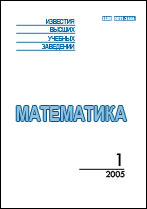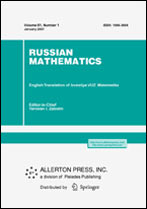|
This article is cited in 1 scientific paper (total in 1 paper)
Refined orthotropic plate motion equations for acoustasticity problem statement
V. N. Paimushinabc, T. V. Polyakovab, N. V. Polyakovab, R. K. Gazizullinb
a Kazan Federal University, 18 Kremlyovskaya str., Kazan, 420008 Russia
b Kazan National Research Technical University, 10 K. Marks str., Kazan, 420111 Russia
c Tatarstan Academy of Sciences,
20 Bauman str., Kazan, 420111 Russia
Abstract:
The formulation of the acoustoelasticity problem is given on the basis of refined motion equations of orthotropic plate. These equations are constructed in the first approximation by reducing the three-dimensional equations of the theory of elasticity to the two-dimensional equations of the theory of plates by using for approximating the transverse tangential stresses and the transverse reduction stress of trigonometric basic functions in the thickness direction. At that, at the points of the boundary (front) surfaces, the static boundary conditions of the problem for tangential stresses are exactly satisfied and approximately for transverse normal stress. Accounting for internal energy dissipation in the plate material is based on the Thompson-Kelvin-Voigt hysteresis model. In case of formulating problems on dynamic processes of plate deformation in vacuum, the equations are divided into two separate systems of equations. The first of these systems describes non-classical shear-free, longitudinal-transverse forms of movement, accompanied by a distortion of the flat form of cross sections, and the second system describes transverse bending-shear forms of movement. The latter are practically equivalent in quality and content to the analogous equations of the well-known variants of refined theories, but, unlike them, with a decrease in the relative thickness parameter, they lead to solutions according to the classical theory of plates. The motion of the surrounding the plate acoustic media are described by the generalized Helmholtz wave equations, constructed with account of energy dissipation by introducing into consideration the complex sound velocity according to Skuchik.
Keywords:
orthotropic plate, refined theory, trigonometric function, energy dissipation, Thompson–Kelvin–Voigt model, longitudinal-transverse form, transverse bending-shear form, acoustoelasticity problem, generalized wave equation.
Received: 07.05.2019
Revised: 07.05.2019
Accepted: 19.06.2019
Citation:
V. N. Paimushin, T. V. Polyakova, N. V. Polyakova, R. K. Gazizullin, “Refined orthotropic plate motion equations for acoustasticity problem statement”, Izv. Vyssh. Uchebn. Zaved. Mat., 2020, no. 5, 62–73; Russian Math. (Iz. VUZ), 64:5 (2020), 56–65
Linking options:
https://www.mathnet.ru/eng/ivm9571 https://www.mathnet.ru/eng/ivm/y2020/i5/p62
|


|





 Contact us:
Contact us: Terms of Use
Terms of Use
 Registration to the website
Registration to the website Logotypes
Logotypes








 Citation in format
Citation in format 
